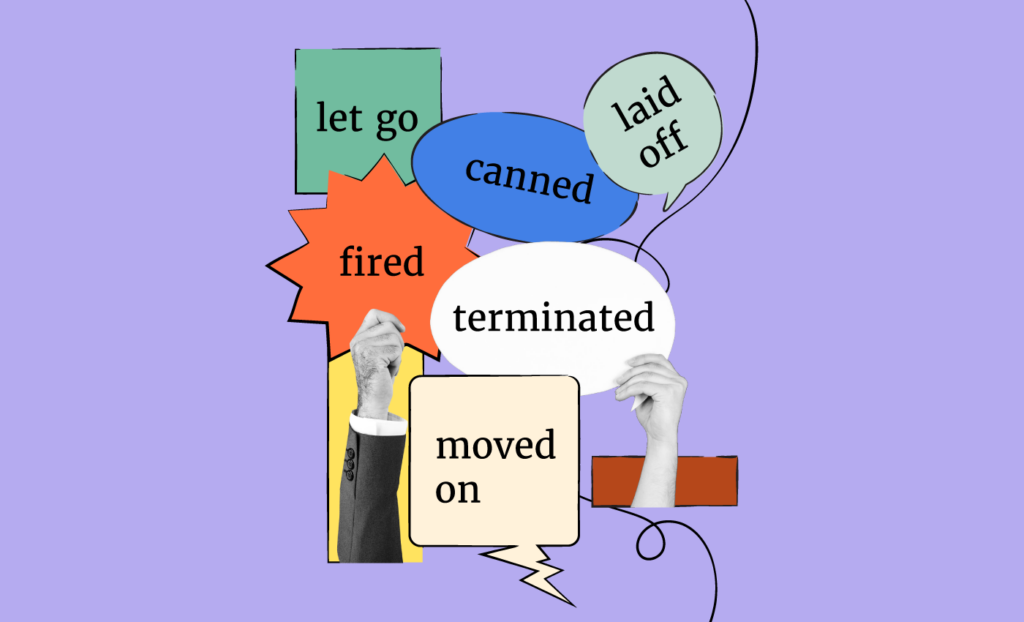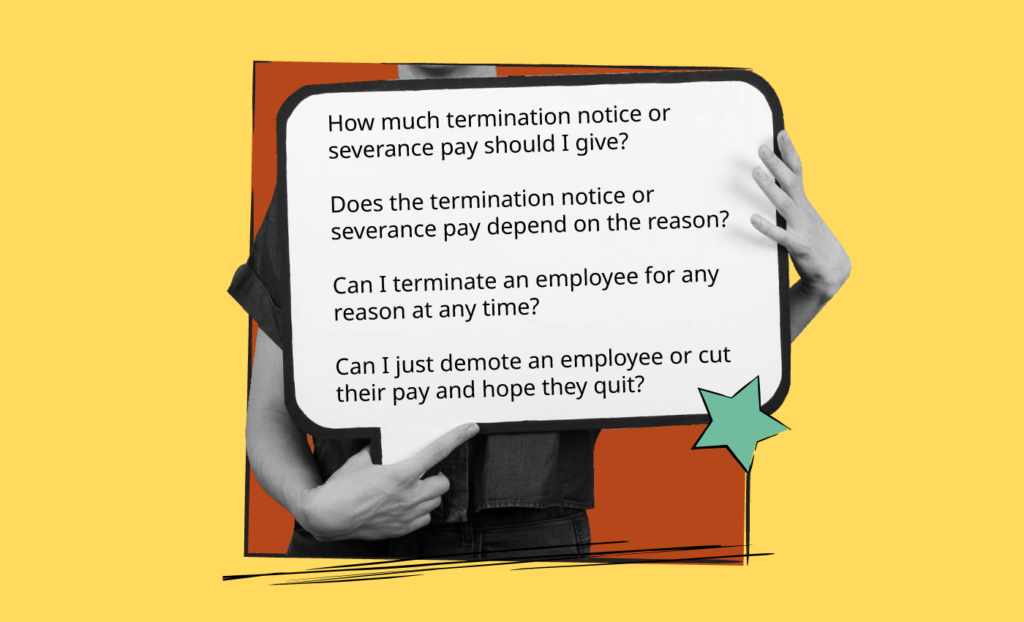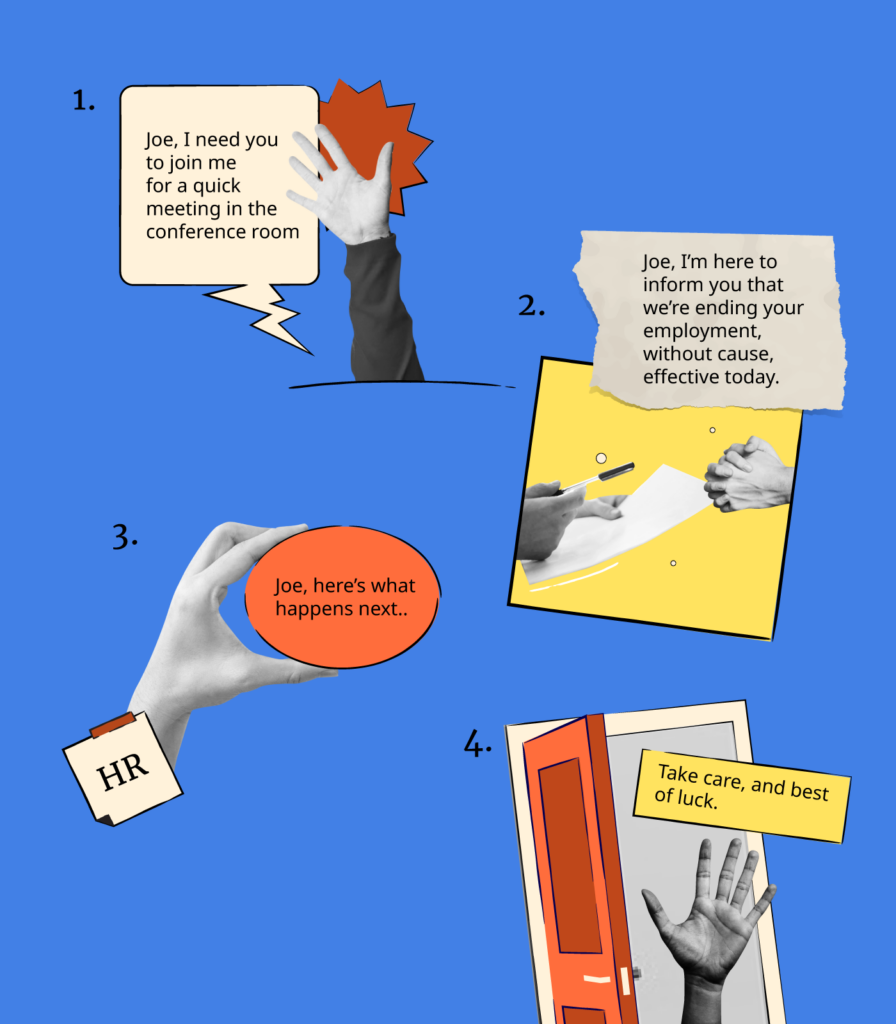Ending someone’s employment is never easy. As someone who’s had to fire employees myself, I know that it’s one of the hardest, most emotional, and most stressful responsibilities leaders and small business owners can have.
Depending on the circumstances, it can also be a complex situation.
The goal of this article is to demystify the employee termination process and minimize stress and trauma for everyone involved.
Taking these appropriate actions when firing someone will create the best possible outcome for you as the employer while still enabling the employee to feel they’ve been treated with respect and leave with some level of dignity.
Reasons To Fire Someone
When we end someone’s employment, we need to remember the impact it can have on them, their families, and the team members they leave behind.
There are also legal and ethical concerns to consider. For this reason, document everything.
Consistent poor performance
When an employee consistently fails to meet the company's performance standards despite being given adequate training and support, termination may be necessary.
Inability or unwillingness to adapt to significant changes in the workplace, such as new technologies, processes, or organizational restructuring, can hinder the progress and evolution of the company.
Violation of company policy or code of conduct
Engaging in behavior that violates organizational policies or codes of conduct, such as harassment, violence, discrimination, or theft, can be grounds for dismissal. This maintains a safe and respectful workplace environment.
Illegal activities or ethical breaches
Involvement in illegal activities or serious ethical breaches, like fraud, embezzlement, or breach of confidentiality, can be serious enough to warrant termination.
Reasons Not to Fire Someone
Before making the very real decision to end someone's employment, consider if it’s something that can be corrected first.
Temporary underperformance
If a previously performing employee is experiencing a dip in performance, don’t just pull the trigger.
They may be going through personal challenges, or perhaps they’re unclear about their role and responsibilities. Maybe a simple conversation will suffice.
Offering support, perhaps in the form of a performance improvement plan, a different position, or even time off, before termination will foster loyalty and long-term productivity.
How To End Someone's Employment Go The Right Way
Follow these best practices to ensure the process is as painless as possible for the individual and wider team.
Must-Do #1: Avoid using the word “fired”
Despite the title of this article, I don’t like using the words “fired” or “terminated” when I talk about ending someone’s employment.
While they get high marks for clarity, they’re harsh and show a lack of respect and empathy toward the people being affected.
On the other hand, if you get too vague, there’s a chance the employee could be left wondering what exactly their employment status is.
For example, a “layoff” actually occurs when there isn’t enough work for the employee at that time but they actually continue to be employed by the company.
“Let go” makes it sound like it was the employee’s decision to leave and you just… let them go?
I prefer saying that someone’s employment has “ended”, which is clear, but not as unpleasant as “terminated”.

Must-Do #2: Be certain firing is the BEST option
There are many valid reasons that might have brought you to this point, whether it’s continued poor performance, misalignment with the organization’s vision and values, or they’re just not the right personality “fit” with you or your team.
Whatever the reason, in these cases be sure to ask yourself some of the following questions before jumping to firing someone:
- Have I put a reasonable effort into correcting underperformance?
- Have I implemented a performance improvement plan?
- Have I conducted regular performance reviews and 1:1 check-ins?
- Is there another position within the organization they might be better suited for?
- Have I checked my observations with other team members and managers?
- Will this be a complete surprise to this employee and to their co-workers?
Of course, in the case where there are more serious or even illegal issues at play, such as fraud, theft, sexual harassment, or violence, the decision to end someone’s employment may be much easier.
Must-Do #3: Dot your i’s and cross your legal t’s

Once you’ve decided to terminate employment, you need to be aware of the following legal and policy issues as they relate to firing someone:
- Company termination policies, whether they’re written in an employee handbook or simply common company practices;
- Employment agreements, which contractually govern the employer / employee relationship, and often include termination clauses;
- Basic human rights protecting people against things like discrimination e.g. the US Civil Rights Act and Canadian Human Rights Act;
- Employment laws, whether they’re state, provincial (e.g. the British Columbia Employment Standards Act), or federal laws (e.g. the Canada Labour Code); and
- Common law practices, which, according to the Canadian Department of Justice, are “laws that are not written down as legislation, but have evolved into a system of rules based on precedent.”
Human resources leaders or an employment lawyer will help you avoid common pitfalls around legal issues such as probationary periods, at-will employment, and termination for cause vs. without cause. They can also answer common questions such as:
- How much termination notice or severance pay should I give?
- Does the termination notice or severance pay depend on the reason?
- Can I terminate an employee for any reason at any time?
- Can I just demote an employee or cut their pay and hope they quit?
For example, in British Columbia, employees are most commonly fired “without cause”, which means their employment can be terminated with no reason given for the termination.
However, if the employee is past their probationary period, they will be entitled to some form of notice or severance. These terminations are different from those “with cause”, which are usually tied to clear, blatant, and serious violations of societal laws or company policies.
Must-Do #4: Draft the termination letter

Once you’ve made the decision to fire someone and checked in with human resources or your employment lawyer, many activities need to happen before the termination meeting.
These need to be done quietly and confidentially, and the only other people who must be involved or aware are your HR leader, your manager, and your IT leader.
The termination letter is a written version of the messages you’ll be communicating during the termination meeting and is given to the employee during that meeting.
The letter states only facts and does not include any reasons behind the termination. It is polite, respectful, and concise, and contains the following information:
- Effective date of termination;
- Whether the termination was with or without cause;
- Severance package details (pay, benefits, health insurance, stock options, etc.);
- Termination benefits the employee may be entitled to e.g. career counseling;
- Post-employment information e.g. official Record of Employment, return of company property; and
- Contact name and information for any questions.
- Warm sign-off sincerely wishing the employee luck in their future endeavours.
NOTE: In some cases where extra severance is being offered, you may request in exchange that the employee sign a release letter by a certain date (often within one week).
Must-Do #5: Prepare communication to the team
It can be a shock to co-workers to see an employee go, especially if they weren’t aware of the employee’s performance or other issues.
Prepare email communication to be sent out to the rest of your team and/or organization (if it’s a smaller company) immediately after the termination meeting.
Make sure to also talk in person with individuals who are more affected by the employee’s departure, whether it’s because they were friends, worked closely together, or are suddenly going to be taking on more work and responsibility.
In all email and in-person conversations, remember to respect your former employee, avoid any disparaging remarks, and avoid sharing the reasons behind your decision.
It can be a shock to co-workers to see an employee go, especially if they weren’t aware of the employee’s performance or other issues.
Prepare email communication to be sent out to the rest of your team and/or organization (if it’s a smaller company) immediately after the termination meeting.
Make sure to also talk in person with individuals who are more affected by the employee’s departure, whether it’s because they were friends, worked closely together, or are suddenly going to be taking on more work and responsibility.
In all email and in-person conversations, remember to respect your former employee, avoid any disparaging remarks, and avoid sharing the reasons behind your decision.
Must-Do #6: Prepare a transition plan for the team
Any time an employee leaves, either voluntarily or involuntarily, there are many necessary offboarding activities.
When someone gets fired, however, many of these activities may need to be arranged quietly.
Some of these activities include:
- Contacting affected customers or suppliers.
- Transitioning responsibilities to other team members.
- Disabling facility, network, and other IT access.
In some cases, you may also want to consider involving or hiring security to help escort the terminated employee off the premises.
I only recommend this in cases where you’re concerned the employee might react aggressively or violently, or if there is a significant risk of theft or damage of company property.
Must-Do #7: Choose the right time and place (and have a witness)
Set yourself up for a smooth termination meeting by picking the right location, day, and time. Here are a few best practices that I’ve learned over the years:
Ensure privacy and quiet
Use a meeting room that doesn’t have windows, or has window coverings. Avoid public places like restaurants and don’t use your office to avoid interruptions from the team.
Avoid Fridays
Getting fired can be traumatizing, and support resources like counselors and therapists don’t often work weekends. Also, avoiding Fridays ensures you or your human resources leader are available the day after if your employee has questions.
Avoid vacations
Unless there’s a time-critical element to the termination, don’t end someone’s employment right before they go on a week-long vacation, for example.
Pick a quieter time of day
Try to arrange the termination meeting to occur at a time when fewer people are around. For example, if the employee is often in the office early before all their co-workers, try to conduct the meeting then.
Meet face-to-face
Getting fired can be a traumatizing life event, so avoid doing it over email, text, or phone, and do it face-to-face.
If you’re in a hybrid workplace, try to conduct the meeting in person on a day when you know they’re in the office. If you’re in a fully remote workplace, however, then do it virtually (they’ll think it’s weird to be called into the office for a “special meeting”).
Have a witness present
It’s important to have someone else in the room to minimize any legal debates around what was, or was not, said.
Generally, this would be someone from human resources, but, if you’re in a smaller business, it might need to be an administrative assistant or other team member you trust.
Must-Do #8: Practice, practice, practice
Firing someone can be a nerve-wracking experience, especially if it’s your first time.
The outcome of the termination meeting will be heavily influenced by how you and your human resources leader conduct yourselves, so draft a script, role-play, and practice. That said, it’s important to be prepared for anything, including your script going off the rails.
You can expect any number of emotions from the terminated employee. I’ve witnessed surprise and shock, even in cases where I’d clearly communicated poor performance beforehand and warned the employee that their employment was in jeopardy.
I’ve seen people get angry, cry, negotiate, or just sit there stone-faced and not talking. If you and your HR representative practice your roles and keep the meeting moving, however, you’ll be okay.
Must-Do #9: Break the bad news quickly and respectfully
It’s time to put your plans, preparation, and practice into action. Following are a series of steps I’ve taken for termination meetings in the past. Keep in mind, however, that every organization and situation is unique, so modify as you see fit.

Step 1: Escort the employee to the meeting room
This can often be a difficult and uncomfortable step for a couple of reasons.
First, the meeting hasn’t been scheduled in the employee’s calendar, so you’re hoping they’re around and haven’t gone out for coffee or something. Sometimes you’ll just need to hang out and wait for them to return.
Once you connect, you’ll say something like the following:
“[Employee name], I need you to join me for a quick meeting in the conference room.”
At this point, they may suspect they’re about to be fired, and begin asking you questions. Just keep reiterating, “We’ll talk once we’re in the meeting room.”
Step 2: Get to the point and avoid small talk
As soon as your employee sees your human resources manager in the room with a serious look on their face, they’ll suspect something is up.
Get seated as quickly as possible, avoid any small talk or idle conversation, and get to the point kindly but firmly. Here’s an example script for terminating someone without cause:
“[Employee name], I’m here to inform you that we’re ending your employment, without cause, effective today. [HR leader’s name] is here to walk you through the next steps, explain things like severance and benefits, and provide you with some resources to help you transition to your next job. [Employee name], I wish you every success in the future. Take care, and best of luck.”
At this point, ideally, you can stand and exit the room. However, your former employee may start asking questions, attempting to negotiate, or getting angry and accusatory. Just keep repeating the following:
‘[Employee name], I’ve provided you with all the information I can. At this point I recommend you let [HR leader’s name] walk you through everything, so you can focus on looking ahead to what’s next for you. Take care, and best of luck.”
Step 3: Close the meeting
If you have an HR representative, they will often take care of this part. If not, it may be up to you. There are a few things to handle after breaking the bad news:
- Paperwork: give them the termination letter, release letter (if applicable), and Record of Employment, and walk them through the details and what they mean.
- Severance package: if they’ve been terminated without cause and are owed notice, explain how that works, what happens with health insurance and benefits, etc.
- Security and property: collect any passes, fobs, phones, laptops, etc. that give them access to the property or network.
Step 4: Escort the employee out
Your HR representative can escort the employee to their desk to collect any personal belongings, car keys, etc.
If they’ve accumulated 20 years' worth of stuff, however, I recommend scheduling a time outside of working hours to allow them to collect it. They may try to chat with co-workers, but it’s best to curtail these conversations by saying:
“[Employee name] we need you to collect your things and make your way out, but please by all means reach out to people after you’re home.”
Finally, escort the employee out of the office or building, but make sure they’re in a state where it’s safe for them to get home. If they’re distraught, for example, offer to call a taxi to get them home.
Must-Do #10: Execute your post-termination plans
Remember all the work you did preparing your communication to the team, getting your transition plans together, and having IT ready to shut down the employee’s network access?
Well, immediately after the employee leaves the building it’s time to execute on those plans.
As you probably noticed, while the termination meeting itself is important, much of the work is in the planning and preparation. By doing the right legwork in advance, you maximize your chances for a smooth transition of the employee out of the organization.
Firing Someone Is an Unfortunate Part Of The Employee Experience
Throughout the entire process of firing someone, remember that the employees they leave behind will be watching very closely how you handled the situation.
Were you empathetic and respectful, or disparaging and thoughtless?
Was it a major surprise to everyone, including the terminated employee, or did everyone see you making every effort to avoid taking such a drastic step?
How you conduct yourself during these stressful situations can make or break your relationship with your team and impact the overall employee experience.
Employee experience software helps with tasks such as communication, support, performance management, and goal setting.
They help with avoiding unfortunate situations such as ending someone’s employment and improving engagement, retention, and performance.
Key takeaways
- Consider alternatives and impact first: Before deciding to terminate an employee, explore all possible corrective actions such as performance improvement plans.
- Legal and ethical preparation: Ensure compliance with legal and ethical standards by thoroughly documenting the process, consulting HR professionals or lawyers, and drafting a respectful and factual termination letter.
- Effective communication and conduct: Handle the termination process with empathy and respect, choosing appropriate language and timing, and preparing for various reactions. Post-termination, communicate effectively with the team, and manage the transition smoothly to maintain a positive workplace environment.
Join the People Managing People Community
For further support on all things talent management, join the People Managing People Community, a supportive community of HR and business leaders sharing knowledge to help you progress in your career and build organizations of the future.


